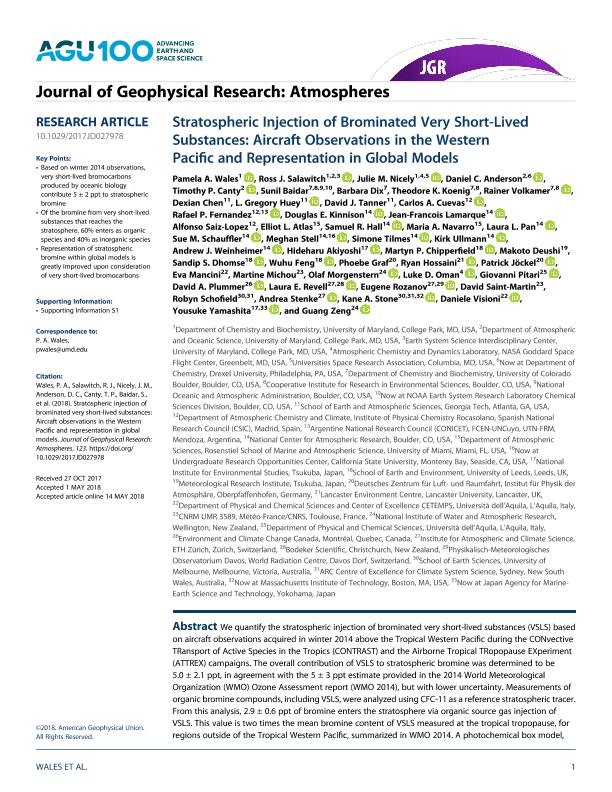Artículo
Stratospheric Injection of Brominated Very Short-Lived Substances: Aircraft Observations in the Western Pacific and Representation in Global Models
Wales, Pamela A.; Salawitch, Ross J.; Nicely, Julie M.; Anderson, Daniel C.; Canty, Timothy P.; Baidar, Sunil; Dix, Barbara; Koenig, Theodore K.; Volkamer, Rainer; Chen, Dexian; Huey, L. Gregory; Tanner, David J.; Cuevas, Carlos Alberto; Fernandez, Rafael Pedro ; Kinnison, Douglas E.; Lamarque, Jean Francois; Saiz López, Alfonso; Atlas, Elliot L.; Hall, Samuel R.; Navarro, Maria A.; Pan, Laura L.; Schauffler, Sue M.; Stell, Meghan; Tilmes, Simone; Ullmann, Kirk; Weinheimer, Andrew J.; Akiyoshi, Hideharu; Chipperfield, Martyn P.; Deushi, Makoto; Dhomse, Sandip S.; Feng, Wuhu; Graf, Phoebe; Hossaini, Ryan; Jöckel, Patrick; Mancini, Eva Elisabet; Michou, Martine; Morgenstern, Olaf; Oman, Luke D.; Pitari, Giovanni; Plummer, David A.; Revell, Laura E.; Rozanov, Eugene; Saint Martin, David; Schofield, Robyn; Stenke, Andrea; Stone, Kane A.; Visioni, Daniele; Yamashita, Yousuke; Zeng, Guang
; Kinnison, Douglas E.; Lamarque, Jean Francois; Saiz López, Alfonso; Atlas, Elliot L.; Hall, Samuel R.; Navarro, Maria A.; Pan, Laura L.; Schauffler, Sue M.; Stell, Meghan; Tilmes, Simone; Ullmann, Kirk; Weinheimer, Andrew J.; Akiyoshi, Hideharu; Chipperfield, Martyn P.; Deushi, Makoto; Dhomse, Sandip S.; Feng, Wuhu; Graf, Phoebe; Hossaini, Ryan; Jöckel, Patrick; Mancini, Eva Elisabet; Michou, Martine; Morgenstern, Olaf; Oman, Luke D.; Pitari, Giovanni; Plummer, David A.; Revell, Laura E.; Rozanov, Eugene; Saint Martin, David; Schofield, Robyn; Stenke, Andrea; Stone, Kane A.; Visioni, Daniele; Yamashita, Yousuke; Zeng, Guang
 ; Kinnison, Douglas E.; Lamarque, Jean Francois; Saiz López, Alfonso; Atlas, Elliot L.; Hall, Samuel R.; Navarro, Maria A.; Pan, Laura L.; Schauffler, Sue M.; Stell, Meghan; Tilmes, Simone; Ullmann, Kirk; Weinheimer, Andrew J.; Akiyoshi, Hideharu; Chipperfield, Martyn P.; Deushi, Makoto; Dhomse, Sandip S.; Feng, Wuhu; Graf, Phoebe; Hossaini, Ryan; Jöckel, Patrick; Mancini, Eva Elisabet; Michou, Martine; Morgenstern, Olaf; Oman, Luke D.; Pitari, Giovanni; Plummer, David A.; Revell, Laura E.; Rozanov, Eugene; Saint Martin, David; Schofield, Robyn; Stenke, Andrea; Stone, Kane A.; Visioni, Daniele; Yamashita, Yousuke; Zeng, Guang
; Kinnison, Douglas E.; Lamarque, Jean Francois; Saiz López, Alfonso; Atlas, Elliot L.; Hall, Samuel R.; Navarro, Maria A.; Pan, Laura L.; Schauffler, Sue M.; Stell, Meghan; Tilmes, Simone; Ullmann, Kirk; Weinheimer, Andrew J.; Akiyoshi, Hideharu; Chipperfield, Martyn P.; Deushi, Makoto; Dhomse, Sandip S.; Feng, Wuhu; Graf, Phoebe; Hossaini, Ryan; Jöckel, Patrick; Mancini, Eva Elisabet; Michou, Martine; Morgenstern, Olaf; Oman, Luke D.; Pitari, Giovanni; Plummer, David A.; Revell, Laura E.; Rozanov, Eugene; Saint Martin, David; Schofield, Robyn; Stenke, Andrea; Stone, Kane A.; Visioni, Daniele; Yamashita, Yousuke; Zeng, Guang
Fecha de publicación:
05/2018
Editorial:
Blackwell Publishing
Revista:
Journal of Geophysical Research: Atmospheres
ISSN:
2169-897X
Idioma:
Inglés
Tipo de recurso:
Artículo publicado
Clasificación temática:
Resumen
We quantify the stratospheric injection of brominated very short-lived substances (VSLS) based on aircraft observations acquired in winter 2014 above the Tropical Western Pacific during the CONvective TRansport of Active Species in the Tropics (CONTRAST) and the Airborne Tropical TRopopause EXperiment (ATTREX) campaigns. The overall contribution of VSLS to stratospheric bromine was determined to be 5.0 ± 2.1 ppt, in agreement with the 5 ± 3 ppt estimate provided in the 2014 World Meteorological Organization (WMO) Ozone Assessment report (WMO 2014), but with lower uncertainty. Measurements of organic bromine compounds, including VSLS, were analyzed using CFC-11 as a reference stratospheric tracer. From this analysis, 2.9 ± 0.6 ppt of bromine enters the stratosphere via organic source gas injection of VSLS. This value is two times the mean bromine content of VSLS measured at the tropical tropopause, for regions outside of the Tropical Western Pacific, summarized in WMO 2014. A photochemical box model, constrained to CONTRAST observations, was used to estimate inorganic bromine from measurements of BrO collected by two instruments. The analysis indicates that 2.1 ± 2.1 ppt of bromine enters the stratosphere via inorganic product gas injection. We also examine the representation of brominated VSLS within 14 global models that participated in the Chemistry-Climate Model Initiative. The representation of stratospheric bromine in these models generally lies within the range of our empirical estimate. Models that include explicit representations of VSLS compare better with bromine observations in the lower stratosphere than models that utilize longer-lived chemicals as a surrogate for VSLS.
Palabras clave:
BROMINE
,
CCMI
,
CONTRAST
,
VSLS
Archivos asociados
Licencia
Identificadores
Colecciones
Articulos(CCT - MENDOZA)
Articulos de CTRO.CIENTIFICO TECNOL.CONICET - MENDOZA
Articulos de CTRO.CIENTIFICO TECNOL.CONICET - MENDOZA
Citación
Wales, Pamela A.; Salawitch, Ross J.; Nicely, Julie M.; Anderson, Daniel C.; Canty, Timothy P.; et al.; Stratospheric Injection of Brominated Very Short-Lived Substances: Aircraft Observations in the Western Pacific and Representation in Global Models; Blackwell Publishing; Journal of Geophysical Research: Atmospheres; 123; 10; 5-2018; 5690-5719
Compartir
Altmétricas



